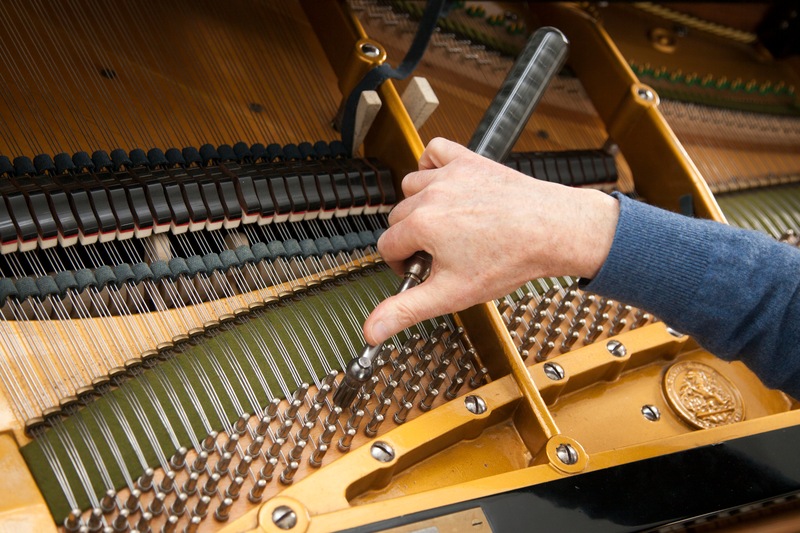Expert Tips for Tuning and Maintenance Post Long-Distance Piano Moving

You've just completed a huge cross-country move, and the piano movers have carefully unloaded and reassembled your treasured instrument in your beautiful new home. What an exciting fresh start! But before you sit down and start playing, there's one crucial step you don't want to overlook – getting your piano tuned and serviced after its long journey.
At Modern Piano Moving, we go to great lengths to protect and care for each instrument during transit with climate-controlled trucks, specialized equipment, and expert handling. However, even with our delicate processes, the reality is that pianos can still go through a lot of stress and environmental changes when being relocated long distances. Things like:
-
Changes in temperature and humidity
-
Vibrations and movements from the truck
-
Subtle shifts in geometry from being disassembled and reassembled
These factors can easily cause your piano to go out of tune and potentially impact other components like the action, keys, pedals, and sound quality. Don't worry, it's normal! With a professional tuning appointment after the move, you'll get everything calibrated and your piano sounds its absolute best in the new space.
As a piano moving specialist, we can't stress enough how crucial it is to tune your instrument after a long-distance relocation. Skipping this service is a surefire way to cause long-term damage and inferior performance. Neglecting to tune and service the piano properly essentially negates all the careful precautions and protective measures we took during the cross-country shipping process.
To help you get prepared, the team at Modern Piano Moving has put together a comprehensive guide on tuning and maintenance for your piano after a move. Follow these tips from our experts to ensure your cherished instrument is in peak playing condition!
Find a Registered Piano Technician in Your New Area
The very first step is to locate a Registered Piano Technician (RPT) who can tune and service your piano in your new area. An RPT has received advanced training and certification from the prestigious Piano Technicians Guild, ensuring they have the knowledge and skills to properly tune, repair, and maintain your specific type of piano.
Most cities will have multiple RPT options, but you'll want to do some research to find technicians who are experienced working on pianos like yours (grand, upright, player piano, etc.) and come highly recommended by previous clients. Don't just hire the first name that pops up - this is an instrument you've trusted a professional piano mover to relocate safely, so you'll want a true expert caring for it.
Schedule the Appointment Soon After the Move
It's best to get your piano tuned and serviced within 2-4 weeks after your move date. This gives the instrument a bit of time to acclimate to the new environment and humidity levels but doesn't leave it going too long in a potentially out-of-tune state.
Many of the steps involved, like tightening strings and calibrating the action, are much more difficult to do when the piano is severely out of tune. By scheduling the appointment fairly soon after the move, the technician can get in there before the instrument drifts too far and has better success with the tuning process.
So even if your piano sounds okay for the first few days post-move, be sure you go ahead and put that tuning appointment on the books right away. It will be much easier to get great results when everything is still relatively in tune.
Be Prepared for Multiple Tuning Appointments
Speaking of getting great tuning results, understand that the first appointment after a big move may not be the final one needed to get your piano perfectly in tune. The initial tuning process essentially "sets" the piano, but additional minor adjustments are usually recommended a few more times to hold that rock-solid tune.
Your RPT will likely suggest coming back to make those final tweaks somewhere between 2 weeks and 3 months after the initial appointment. The exact timing depends on factors like:
-
Age and condition of the piano before the move
-
Distance and climate changes during the relocation process
-
Temperature and humidity levels in your new home
Follow your tuner's guidance, but don't be surprised if they ask to return for one or two additional sessions to optimize the piano's tuning. It's a normal part of the process!
Ask About a Regulation and Voicing Service
While the tuning aspect is crucial for getting your piano to sound its best, most technicians will also recommend a full regulation and voicing service after you move. Put simply, regulation refers to making precision adjustments and alignments on all the physical components that impact playability and responsiveness. Voicing tweaks the felt hammers inside to perfect the tone and evenness of the piano's sound.
Even if your piano seemed to be functioning flawlessly before the move, those vibrations, humidities, and geometry shifts can knock things slightly out of whack and cause issues like:
-
Uneven tone and volume across different ranges
-
Keys sticking, clicking or not responding consistently
-
Pedals not operating smoothly
-
Overall sluggish or stiff mechanical feel
A skilled technician will thoroughly check over the entire piano during the appointment, making any necessary adjustments and refinements to ensure peak performance, tone, and mechanics. It's a worthwhile service that breathes new life into an instrument after it's been through the stress of relocating.
On grands, the technician may even recommend repacking specific sections of the instrument – such as re-keying the action – to restore that brand-new feel and responsiveness that may have loosened up over the move.
Understand Costs Involved
Of course, any work from a professional piano tuner and technician will involve service costs. Rates can vary based on factors like your geographic area, the type and size of piano you have, and the specific services requested.
As a general baseline in most markets, you could expect to pay somewhere around:
$150-$250 for an initial tuning service
$200-$300 for a tuning plus full regulation service
$75-$150 for any follow-up tuning adjustments needed
$100-$200 per day for advanced repair work if issues are found
While it may seem like a big investment, remember that having your piano professionally tuned after a move is a relatively small price to pay for protecting the longevity and performance of your instrument that's worth thousands of dollars.
Start with Local Recommendations
As you begin researching different RPTs in your new area, start by asking around for recommendations. Check with any local music teachers, university music programs, or even your new neighbors - chances are they'll have someone they regularly use and trust for piano tuning services.
You can cross-reference those names against reviews online and credentials from associations like the Piano Technicians Guild. Most reputable technicians will have a website or online presence with details about their background, services offered, and rates.
Don't skip this critical post-move maintenance for your piano! With some simple tuning adjustments and services from an expert, you'll have your treasured instrument sounding and performing like new again in no time.
At Modern Piano Moving, we take great pride in our profession as specialists in piano transport and relocation. But we know our job is only half the journey - your RPT tuner is the key partner for ensuring everything is perfectly dialed in by the time you sit down to play at your new home.
Follow these tips from our team to find the perfect tuning technician. With their expert services partnered with our careful white glove piano moving process, you can rest assured your instrument will sing out beautifully in its new environment for years to come!
Bookmark & Share
User Comments
Be the first to comment on this post below!
Previous Article
Most Popular Articles
- How Much Does It Cost to Move a Piano Long Distance?
- How Heavy Is A Grand Piano?
- Easy Pop Songs to Play on the Piano
- The Best Spots for Your Piano
- Mistakes to Avoid When Moving a Piano
- 10 Reasons to Hire a Professional Piano Moving Company
- How to Restore Yellow Piano Keys
- What to Do with Your Unused Piano



